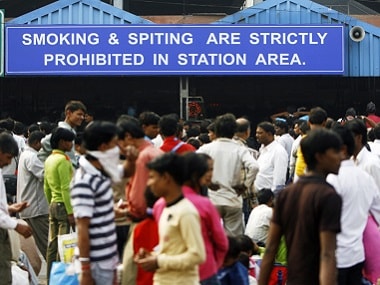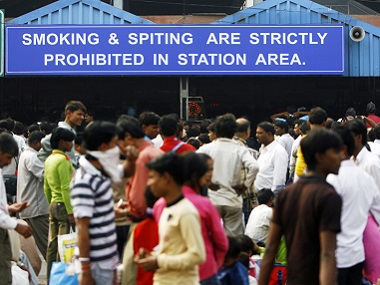Couple of weeks ago, something unusual happened during the Question Hour session in the Rajya Sabha. On the question posed by member of Parliament (MP) Mohammad Nadimul Haque from Bengal on what was being done to curb what another MP and senior Supreme Court advocate called “The Great Indian Spit”, parliamentarians rose above their regular party politics to deride the age-old habit. Displaying unusual unity, members posed questions that ranged from whether scientific studies had been conducted to assert the harm done by spitting in public, to would the government consider banning tobacco and pan completely. But some also got their point across with a dash of humour with Nadimul Haque’s remark wittily summarising the habit when he said, “Sir, India is a spitting country. We spit when we are bored; we spit when we are tired; we spit when we are angry or we spit just like that. We spit anywhere and everywhere and we spit at all times and at odd hours”. Health Minister JP Nadda could only sheepishly remark to hold an inter-sectoral meet on the issues raised and later assured the MPs that an advisory to take cognisance of the habit will be passed to all states. [caption id=“attachment_2939768” align=“alignleft” width=“380”]  Representational image. AFP[/caption] So what makes us a spitting people? A spitting nation? How widely prevalent is the habit across the country? Raja Narasimhan, who runs the Spit Free India campaign as part of his organisation Sare Jahan Se Acha, has an interesting insight. According to him, “There are certain things that become peculiar habits and it gets difficult to correct them. It is infact becoming a culture with many sections of the society. People driving in Mercedes also spit and a labourer spits too. So it has become a nasty habit which we have allowed to develop over many years." Having travelled all over the county on a recent journey from Kashmir to Kanyakumari, Narasimhan says no part of the country has been spared by the pockmarks of “The Great Indian Spit”. According to him, the dreaded red stains may be less visible in the Southern part of the country probably because the culture of chewing pan is more prevalent in the Northern states and the rest of the country more than makes up for it. If it is not mouth pichkari then it is a lungful blast of tobacco. Climbing the stairs at most government buildings in Mumbai, it would be hard to miss the judiciously sprayed bloody marks in the corners. Narasimhan amusingly relates such markings to a tiger spraying it territory in a forest. But maybe civil society should not bear the entire brunt of the blame. Lack of and disappearance of spittoons from our modernised urban sprawls may also be a factor in people spitting randomly everywhere. Till the ’70s, municipal corporations would place spittoons, some filled with sand along electricity poles. But with the change of times and lack of staff to carry out such unpleasant tasks of cleaning the spittoons, authorities have been dissuaded from erecting them. Depiction of spitting has also changed to in our popular culture. In our present day movies, spitting on the side to show disgust and power is a prerequisite to heroic machismo. Compare this to movies from the previous generation where comic scenes, for instance, were shown with pan chewing men and women who inadvertently would spit in a spittoon. Shekar Menon of Final Mile, a behavioural architects consultancy, did some detailed research a few years ago into how to keep the area around his office spit free. He and his colleagues tried to understand the whole cycle of where people buy their spitting ammunition from, when they buy it and ultimately finding out what causes people to spit. His analysis found, “There are two kinds of spitters, one is a conscious spitter like the pan chewers who even before buying knows he has to spit it out.” The other are unconscious spitters. Menon thinks the conscious spitters look for anonymity and designated spots to relieve their mouth fluids. So after identifying the usual spitting spots, Menon started a campaign and got those areas painted with images of human eyes, showing as if somebody were watching the spitters taking away the feeling of anonymity from them. On the other hand Menon and his team formed an understanding with their surrounding offices to inform their employees to spit in designated spots only like a washroom sink. Such initiatives changed the conscious spitters usual habits. The unconscious spitters, he reckons just need educating and telling off as they are not as big a nuisance as the conscious spitters. Such innovative deterrents have not always worked. Municipal corporations have had Indian deities’ images painted on walls near footpath in order to keep them clean, but even these deities are not spared. One cannot always fault the common man on the streets when our politicians show scant regard for civic etiquette. The inimitable Lalu Prasad Yadav could easily carry the spitting baton among politicians and he displayed no hesitation in relieving himself in Gaya in 2007. Ironically he continues to be imitated across India’s bus stops, railway stations, roads, even hospitals and other public spaces. Even the threat of hefty fines has been unsuccessful in breaking habits of habitual offenders. Most municipalities have well defined laws against spitting but these are rarely enforced due to lack of will and man-power. Regular anti-spitting drives are launched by the Brihanmumbai Municipal Corporation but to little effect. Social and health workers are banking on the fact that the spread of easily communicable diseases like TB, influenza and even swine flu can be contacted from people spitting. But Narasimhan reckons unless the problem is eradicated from its roots, we would continue to fish on the surface. So his organisation is reaching out to around 100 schools in educating primary and secondary children advising against developing habit of spitting in public and also creating awareness about it. It has been hugely successful in spreading the word as kids inturn educate the elders around them. Narasimhan says, “This approach works better than publicly reprimanding an adult for the act as it hurts his ego”. The programme is showing promise of expanding across the country as a volunteer in Gantok has taken up the gauntlet with the municipal corporation there. Such programmes along with wider public awareness campaigns by governments — like the ones created by the Chinese to tackle the problem in a more cultural-evolutionary way — would go a long way in keeping our public spaces stain free. Singapore, on the other hand, implemented laws against spitting with an iron fist but in that country there anyway is a strict adherence to the law. It is abundantly clear that there are multiple behavioural, cultural and legal approaches that can be drawn on to wipe the ugly stains from our walls. If the government is serious about building a clean, healthy society with its Swacch Bharat campaign, then it would do well to tackle spitting as much as it tackles defecation by building public toilets. At the same time, the civil society at large must hold a mirror to itself rather than spitting in its face.
So what makes us a spitting people? A spitting nation? How widely prevalent is the habit across the country?
Advertisement
End of Article


)
)
)
)
)
)
)
)
)



